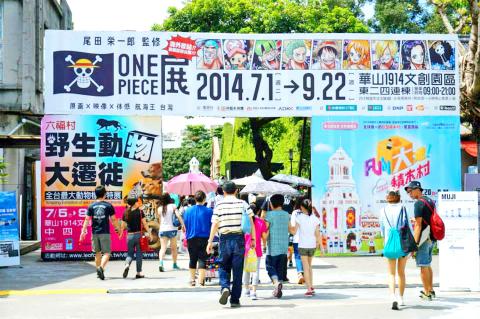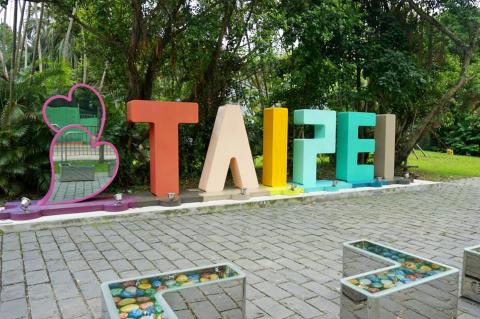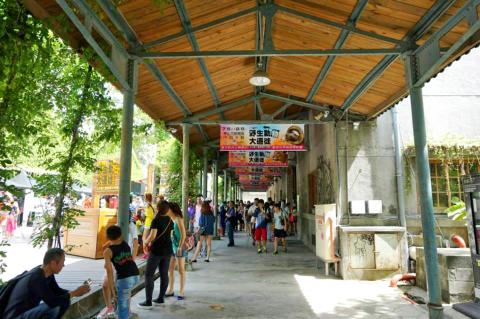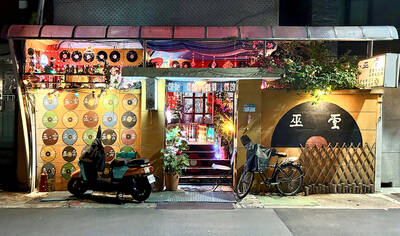Since Ko Wen-je (柯文哲) became Taipei mayor late last year, his administration has produced a regular stream of startlingly direct announcements. The latest was a harsh critique of creative and cultural industries, in which the commissioner of the Taipei Department of Urban Development, Lin Jou-min (林洲民), declared Huashan 1914 Creative Park, Songshan Creative Park and several others to be “fake cultural parks” in a Facebook post on Sunday.
“To you CEOs who have no intention of fostering real creative industries, please get back in your black sedans and get out of Taipei! As long as you are here, Taiwan’s artists will forever be second class citizens,” he wrote.
Lin is right. Taiwan set out to develop “cultural parks” in the late 1990s, and for the most part they have now turned into cultural shopping malls. Huashan now rents the front lawn for beverage advertisements and the exhibition spaces are mostly inhabited by plug-and-play events for candy manufacturers, exhibitions of Beatles memorabilia and, on a good weekend, perhaps a National Geographic photo exhibition. There is no artistic community and a very limited sense that local arts groups have any investment or meaningful participation in these cultural parks.

Photo: Dana Ter, Taipei Times
Money grab
To a large degree, the exhibitions and events are put on by a new breed of professional event and exhibition groups that formed over the last decade in order to gobble up the new government budgets created to promote “cultural and creative industries” — a government project which has now become a buzzword. The Honhai Group, one of Taiwan’s richest companies and the manufacturer of iPhones and other Apple products, invoked the banner of “cultural and creative industries” to build a new building between Huashan and the Guanghua Computer Market, the Sanchuang Digital Life Plaza (三創數位生活園區). By waving the culture flag, one of the richest companies in Taiwan got the land on which the building is constructed for free. When the plaza opens in the next few months, Taipei will see that it is nothing other than an upscale shopping mall.
One of the problems is the conception of cultural and creative industries. In the minds of government and industry, every venture is supposed to make money immediately and every event is supposed to result in direct sales. This mentality is essentially that of a nation that understands manufacturing but little else. There is no sense that creativity needs room and freedom to incubate and grow.

Photo: Dana Ter, Taipei Times
This is why Taiwan will continue to lag behind South Korea and Japan, and it is also falling behind China, when it comes to creating films, music and other salable cultural products. Taiwan’s films are mostly considered unwatchable by international audiences, despite the legacy of Hou Hsiao-hsien (侯孝賢) and Taiwan’s new wave cinema in the 1990s. The pop music industry is dying and has little idea on how to manufacture new stars. The ongoing decline of Taiwan’s actual money-making cultural industries is all the more reason to protect places where the arts can flourish.
Taiwan gained a reputation for indie culture in the 1990s and 2000s, including the indie music scene, auteur cinema, experimental theater groups and artist-run art galleries, as well as the loose agglomeration of coffee shops, live houses and other businesses where creative types liked to hang out. This could not be found in Singapore or Hong Kong, where rents were too expensive.
China lagged behind Taiwan in the 1990s due to a repressive government, but even with moderate liberalization in the last 15 years, it has surpassed Taiwan in contemporary art and indie music. Part of this comes on the strength of China’s massive population and huge market size. Another part of the reason is that artists had space to self-organize, as in Beijing’s 798 Arts District.

Photo: Dana Ter, Taipei Times
Beijing’s 798 arts district
798 started off very similar to Huashan. Both are factory spaces discovered and settled by artist squatters. 798 has now become highly professional and in many senses commercialized, even “touristy,” but it is still focused on contemporary art, and is home mainly to artist studios and commercial galleries. Huashan kicked out all the artists long ago, and many of them can no longer afford the rent. Though Huashan contains a music performance space (Legacy) and an independent cinema (Spot Huashan), it treats culture as a commodity to be sold, not as an atmosphere to be experienced.
Taiwan’s real challenge is how to harness the “cool energy” of all the indie kids running around throwing funky parties for a few dozen friends, and turn it into something bigger. Professionalism will be part of the equation, but right now there is a huge disconnect between the professionals, who merely swoop in to grab government contracts, and the creative types, who meander from one government grant to the next. Lin’s harsh critique is not the ultimate answer, but it seems a good start in refocusing priorities.

Photo: Dana Ter, Taipei Times

The Lee (李) family migrated to Taiwan in trickles many decades ago. Born in Myanmar, they are ethnically Chinese and their first language is Yunnanese, from China’s Yunnan Province. Today, they run a cozy little restaurant in Taipei’s student stomping ground, near National Taiwan University (NTU), serving up a daily pre-selected menu that pays homage to their blended Yunnan-Burmese heritage, where lemongrass and curry leaves sit beside century egg and pickled woodear mushrooms. Wu Yun (巫雲) is more akin to a family home that has set up tables and chairs and welcomed strangers to cozy up and share a meal

Dec. 8 to Dec. 14 Chang-Lee Te-ho (張李德和) had her father’s words etched into stone as her personal motto: “Even as a woman, you should master at least one art.” She went on to excel in seven — classical poetry, lyrical poetry, calligraphy, painting, music, chess and embroidery — and was also a respected educator, charity organizer and provincial assemblywoman. Among her many monikers was “Poetry Mother” (詩媽). While her father Lee Chao-yuan’s (李昭元) phrasing reflected the social norms of the 1890s, it was relatively progressive for the time. He personally taught Chang-Lee the Chinese classics until she entered public

Last week writer Wei Lingling (魏玲靈) unloaded a remarkably conventional pro-China column in the Wall Street Journal (“From Bush’s Rebuke to Trump’s Whisper: Navigating a Geopolitical Flashpoint,” Dec 2, 2025). Wei alleged that in a phone call, US President Donald Trump advised Japanese Prime Minister Sanae Takaichi not to provoke the People’s Republic of China (PRC) over Taiwan. Wei’s claim was categorically denied by Japanese government sources. Trump’s call to Takaichi, Wei said, was just like the moment in 2003 when former US president George Bush stood next to former Chinese premier Wen Jia-bao (溫家寶) and criticized former president Chen

President William Lai (賴清德) has proposed a NT$1.25 trillion (US$40 billion) special eight-year budget that intends to bolster Taiwan’s national defense, with a “T-Dome” plan to create “an unassailable Taiwan, safeguarded by innovation and technology” as its centerpiece. This is an interesting test for the Chinese Nationalist Party (KMT), and how they handle it will likely provide some answers as to where the party currently stands. Naturally, the Lai administration and his Democratic Progressive Party (DPP) are for it, as are the Americans. The Chinese Communist Party (CCP) is not. The interests and agendas of those three are clear, but